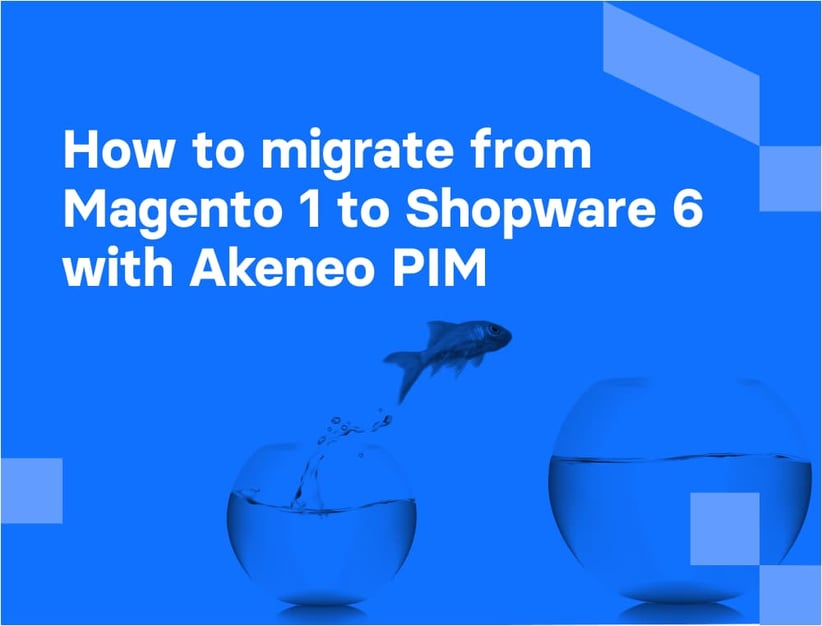As support for Magento 1 reaches end-of-life on 30 June 2020, the question for those still using the platform is whether to stick with what is familiar and trusted by upgrading to Magento 2 or to look at the capabilities of other solutions and migrate to something now. There are hundreds of options out there but, for those thinking of migrating from Magento 2, the innovation of Shopware 6 coupled with the ease-of-use of Akeneo Product Information Management could provide a strong foundation for a new ecosystem.
Why Shopware and Akeneo?
Changing your online shop can take a lot of time and effort since existing data must be adapted and prepared for the new system. By combining Shopware 6 and Akeneo, the problem and the associated risks are reduced to a minimum. You can safely and quickly transfer all your customers with their passwords, as well as the entire data product structure with necessary categories and attributes and products themselves.
These solutions reduce the management time, expense, and difficulty associated with running an eCommerce store. Here are some of the benefits of connecting Shopware 6 with Akeneo PIM for your online eCommerce store:
Shopware benefits
1. Shopware 6 is a lean and extremely flexible product that can be easily adapted to meet your needs.
2. The application’s frontend and backend are independent, making upgrades quicker to deploy and allowing it to be implemented as a headless eCommerce.
3. The platform has an extremely fast frontend with an optimized mobile experience. Progressive Web Apps are an excellent solution for merchants looking to capitalize on the explosion of commerce on mobile devices.
4. Merchants can use the platform as the hub for all retail operations: regional websites, headless applications, POS, or even Amazon and eBay stores.
5. Shopware 6 has a very intuitive and graphically refined admin panel which, together with the innovative Akeneo system, will feel like a serious upgrade for many who have used Magento 1 for a number of years.
Learn more about our Shopware Development Services: Visit website
Akeneo benefits:
1. The platform overcomes the limitations and costs of processes related to creating content, product design and management, and supply chain management. Ensure constant information flow, check you are up-to-date, and monitor actions in real-time.
2. It minimizes incorrect data, avoids duplication of work, reduces errors, and gains consistent information across all channels.
3. Vendors can reduce time-to-market, find bottlenecks in their process, and check which data matters to customers.
4. Akeneo has automatic publishing procedures, consistent product data across all channels, and the ability to show users where products are currently available.
Find out more about Akeneo development services from Divante: Visit webpage
The benefits of migrating from Magento with Shopware 6 and Akeneo
Here is what you need to know about your upcoming migration if you chose flexible Shopware 6 with the easy-to-use Akeneo PIM. Get clued up on three key benefits:
1. Reduce risk with the Magento/Shopware migration tool
Free and easy to use, the high-performing migration tool helps you transfer your data to Shopware 6 through the administrative panel. You can take advantage of this opportunity and organize your information and filter only the data you want to migrate to the new system.
The migration interface is easily extendable and adaptable so, with very little development, you can add or change functionalities to suit your specific use case.
2. Third-party Akeneo and Shopware 6 Connector
You can easily optimize and customize product export to your needs and transfer data automatically or at a single touch. Moreover, the connector gives access to features like:
- Customizable Attribute Mapping which is accessible also for custom values. Filter data can be exported based on category, family, completeness, or identifier(SKU)
- Language and currency for product export
- The Quick Export feature which allows you to quickly export a product to Shopware 6
3. The transition to a distributed architecture with a separated PIM system, backend, and frontend.
This solution increases the efficiency of the entire ecosystem and the flexibility of architecture development. Gaining full control over technical debt is a significant advantage. Developers will appreciate the organization of the code, and new functionalities will be delivered to the end-user faster.
Simplified migration process
In short, the whole migration stage we can be divided into the following steps
- Migrate data from Magento to Shopware
- Export data from Magento into a CSV file
- Prepare import files and import data to Akeneo
- Import necessary data from Shopware to Akeneo
- Export all product data and structure from Akeneo to Shopware
Of course, we will not be able to migrate everything. CMS pages and static blocks are not transposed and these have to be redesigned in the Shopware platform.
How to strategically prepare for migration
Migration is a complex operation and can cause some issues. That is why it is important to put in the planning time before migration to eliminate all possible undesirable effects.
Considered analysis plays a key role here. Don’t rush into it; trace the whole process from beginning to end and make sure that you don’t miss anything. Forewarned is forearmed.
Another small tip; just as in any other IT project, you should always have to back up your data before starting any operations. That way, if you take a wrong turn, nothing is lost.
It’s also good to get acquainted with the new vocabulary that appears in Shopware. Most elements remain the same but there are differences. For example, Configurable Products are now called Variants. Don’t try to move all functionalities on a one-to-one scale. However, Shopware is very well prepared and all differences in the vocabulary can be found on their website.
Migration is also not the best time to experiment with the introduction of innovations and improvements. Try to keep what is fundamental for your company and the values that have always distinguished your brand.
We build eCommerce, so sales channels must be maintained. It is, therefore, necessary to look at integration and data transfer processes, ensuring that all sales channels we care about will be maintained.
Looking at technical aspects, such as system requirements, we can change or adapt our servers but should make as few changes as possible to keep the whole process smooth. Shopware generally supports most Unix-based operating systems. At the end of this article, you’ll find relevant links to more information concerning many areas, such as system requirements.
Analysis and prioritization are the keys to success
When we have taken the first steps, we should create a list of functionalities in a workshop and prioritize them accordingly.
We then check which ones we receive directly in Shopware and which require plugins (you can check in advance on the official Shopware website). If a feature is not included, it is worth checking whether it can be found in Shopware 5 plugins as it’s possible that developers will also map it to version 6. Ask if they plan such a move and about the approximate delivery time.
In the absence of a given functionality, we must already assess how important it is and plan development work properly or try to replace it with another that meets our expectations. The next stages of preparation are already part of the migration process, such as adequately configuring the Shopware migration tool or structuring the files to be imported into Akeneo.
Summary
The more time we devote to preparing for migration, the more we save during the process itself. Now you know the value of migrating from Magento 1 to Shopware 6 with Akeneo PIM. If your eCommerce is ready to grow, combining these two technologies seems like one of the very best ways to achieve that aim.
Schedule a demo to see how Divante can help you execute a successful migration from Magento 1 to Shopware 6 with an Akeneo PIM.
You probably have some questions about how to handle such processes in detail
- How to install the migration tool in Shopware?
- How to set up a connection to M1?
- Which elements are simple and quick to develop and which are complicated?
- What is the appropriate Shopware configuration before data migration?
- What does data migration from M1 to Shopware entail?
- How to download a CSV file from M1?
- How to customize the structure of Akeneo import files?
- How to install the Akeneo-> Shopware connector and import data from Shopware to Akeneo?
- How to properly map attributes in the connector?
- How to create import and export profiles?
- How to import necessary data from Shopware to Akeneo?
- How to export data to Shopware from Akeneo?
Let us know which of these is most pertinent to you and we will happily create future articles to explain it in detail.
More interesting data:
- Shopware 6
- Akeneo
- Shopware migration tool
Published June 24, 2020













